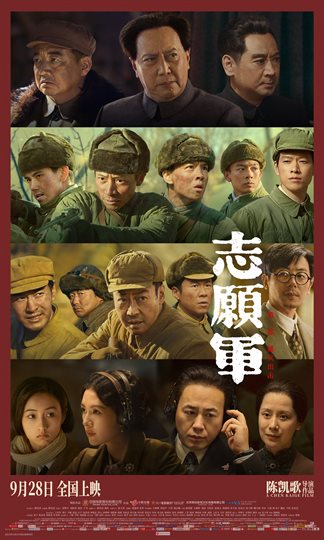26 वीडियो, टैग: War
志愿军:第二部 / 志愿军:雄兵出击2 / 志愿军:再起风云 / 志愿军三部曲2 / 抗美援朝(第二部) / 伟大的胜利2 / 战与祀 / The Volunteers: To the War 2
It tells the story of the third to fifth battles in the War to Resist U.S. Aggression and Aid Korea, among which Battle of Cheorwon will be the highlight. Li Xiang , Fu Chongbi, Cai Changyuan from 63rd Army and others will come on Stage.
孤战 / 失落在东经97度的记忆 / 失落97度的记忆 / The Lost
On the eve of the victory of the Anti Japanese War, Ou Xiao'an, an underground party member of the Communist Party of China lurking in the military statistics department, escaped from the prison of the Japanese Biochemical Poison Gas Research Institute. He was seriously injured and unconscious on the way, and was found and rescued by the Chinese Expeditionary Force. A...<!-- --> <a class="ipc-link ipc-link--baseAlt" role="button" tabindex="0" aria-disabled="false" data-testid="plot-read-all-link" href="plotsummary?ref_=tt_ov_pl">Read all</a>
60fps版 / 志愿军三部曲1 / 伟大的战争·抗美援朝 / 伟大的胜利 / 战与祀 / The Great War
The film will start with the decision of the central government to enter the Korean War and end with the signing of the armistice agreement. It will show the great deeds of the heroic people's volunteers in the war to resist US aggression and aid Korea in a panoramic and multi-level way.
朝鲜战争纪录片
The film highly restores and comprehensively reviews the course of the War to Resist U.S. Aggression and Aid Korea. It details the difficult decisions of the Party Central Committee, the secret deployment of the Volunteer Army to North Korea, major battles, the Korean armistice negotiations, the triumphant return of the Volunteer Army and other major historical events. It also details some of the heroes and models of the Volunteer Army. The fighting collective and their epic heroic deeds.
The documentary takes the course of the War to Resist U.S. Aggression and Aid Korea as the main narrative line. It discloses the inside story of the decision-making and historical details in a panoramic, true and authoritative manner for the first time. It fully demonstrates the far-sighted political wisdom and strategic vision of Mao Zedong and the Party Central Committee, as well as the superb military strategy and command art; China and North Korea The great fighting friendship forged with blood by the Chinese people fighting side by side; and the great spirit of resisting U.S. aggression and aiding Korea forged by the Volunteer Army commanders and fighters when their weapons and equipment were at an absolute disadvantage, this spirit has been in China's subsequent socialist revolution and socialist construction It played a huge role and is still widely praised today.
长津湖战役纪录片
The August First Film Studio Documentary, the Battle of Changjinho, the eastern front of the second campaign to resist U.S. aggression and Aid Korea, was the bloodiest battle of the Korean War. At that time, the 9th corps, with a strength of 160,000, successfully divided and encircled the U.S. Army's 1st Marine Division and 7th Infantry Division in the north-eastern r...<!-- --> <a class="ipc-link ipc-link--baseAlt" role="button" tabindex="0" aria-disabled="false" data-testid="plot-read-all-link" href="plotsummary?ref_=tt_ov_pl">Read all</a>
三国演义(动漫版) / 最強武将伝 三国演義(日) / 三國演義(台)
The 52-episode animation blockbuster "Romance of the Three Kingdoms" co-produced by China and Japan was completed on March 17, 2009, and launched on CCTV on August 1, 2009.
The animated version of "Romance of the Three Kingdoms" discussed broadcast matters with more than 30 TV organizations from 13 countries including the United States, Britain, France, Italy, and Russia, and launched it on mainstream Western animation channels such as Japan, Europe, and the United States. In Japan, the film's first edition of the manga book is expected to print and publish 1 million copies for the first time.
The intricate and tense struggle among the three strongest political forces in the Three Kingdoms period, Cao Cao, Sun Quan, and Liu Bei, embodies the endless emergence of outstanding figures of that era, as well as their heroic behavior and high-strength strategies.
高清修复版 目前最清晰 / 央视94版三国演义
In an age of turmoil, heroes will rise. . . It is the end of the 2nd Century and China is in a state of turmoil. The land is divided by warlords and the country is facing famine, droughts, and invasion from bordering tribes. On top of the problems the country is facing, Zhang Jiao and his brothers begin to rebel against the Han, while advocating the arrival of a new era, the era of the "Yellow Dragon," implying that if people followed him, they would lead prosperous lives. Thousands of desperate villagers flocked to follow Zhang Jiao as they raided government offices and plundered towns and villages alike in protest of heavy taxation, wearing only a "yellow turban" on their heads. As their strengths and numbers grew, the "Yellow Turbans" overthrew some of the Imperial Court's best generals and strongest forces. Concerned for their capital in Luo Yang and for the Han empire, the Imperial Court immediately constructed an "alliance" by requesting volunteers across the country to settle the rebellion. Three distinct generals were recruited - Liu Bei, Cao Cao, and Sun Jian. Together with their own officers, the Yellow Turban rebellion was quickly laid to rest and each of the men involved immediately gained popularity and power with the people. As their powers grew, however, each continued to seek more control of their territories and to unite all of China under one rule. One fought for hegemony. One fought for ambition. One fought for righteousness. Veteran officers and generals who shared the same visions swarmed under each leader. These stalwart souls waged war across the vast expanse of the land and, like blood thirsty demons, cut down any and all that stood in their way. Thus, the romance of the Three Kingdoms begins . . .

























